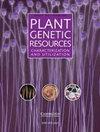In-vivo haploid induction potential of Himalayan maize (Zea mays) and cogon grass (Imperata cylindrica) gene pools in different segregational cycles of intra and inter-generic crosses of wheat
IF 0.7
4区 生物学
Q3 PLANT SCIENCES
Plant Genetic Resources: Characterization and Utilization
Pub Date : 2022-01-24
DOI:10.1017/s1479262121000642
引用次数: 1
Abstract
Maize and Imperata cylindrica have been utilized globally as a pollen source for induction of haploids in wheat through chromosome elimination technique. Pollen parents with a higher haploid induction rate are desired for recovering the high frequency of haploids in wheat and related species. The present investigation was carried out with the aim to assess haploid induction efficiency of diverse germplasm of maize and I. cylindrica in different generations of intra and intergeneric crosses of hexaploid and tetraploid wheat and triticale-wheat derivatives. Crosses of twenty-six lines (female) with each of two I. cylindrica and twenty-one maize genotypes (testers) were evaluated for four haploid induction parameters viz., pseudoseed formation frequency (PFF), embryo formation frequency (EFF), haploid regeneration frequency (HRF) and haploid formation frequency (HFF). I. cylindrica outperformed maize in haploid induction rate with a frequency of embryos formed with I. cylindrica (18.39%) were significantly higher as compared to maize (4.08%). In the case of I. cylindrica genotype Ic-ye identified best with mean EFF of 30.55, 14.48 and 25.43% for hexaploids, tetraploids and triticale × wheat derivatives, respectively whereas in the case of maize genotype HPMC-60 performed best with EFF of 12.61% for hexaploids, HPMC-58 (12.58%) for tetraploids and HPMC-16 for triticale × wheat derivatives with EFF of 8.91%. I. cylindrica genotype Ic-ye and maize genotypes HPMC-14, HPMC-53, HPMC-60, HPMC-64 with significantly positive GCA for haploid induction parameters may be utilized as efficient pollen parents for recovering higher frequency of haploids in wheat.小麦属内和属间杂交不同分离周期喜马拉雅玉米(Zea mays)和白茅(Imperata ica)基因库的体内单倍体诱导电位
利用玉米和白茅作为花粉源,利用染色体消除技术诱导小麦单倍体。小麦及其近缘种需要具有较高单倍体诱导率的花粉亲本来恢复单倍体的高频率。本研究旨在评价玉米和白茅不同种质在六倍体和四倍体小麦及小黑麦-小麦衍生物的属内杂交和属间杂交的不同代诱导单倍体的效率。用26个(雌)系与2个白茅基因型和21个玉米基因型的杂交进行了4个单倍体诱导参数的评价,即假种子形成频率(PFF)、胚形成频率(EFF)、单倍体再生频率(HRF)和单倍体形成频率(HFF)。单倍体诱导率优于玉米,单倍体胚形成率(18.39%)显著高于玉米(4.08%)。在白茅基因型中,Ic-ye对六倍体、四倍体和小黑麦×小麦衍生物的平均EFF分别为30.55、14.48和25.43%,而在玉米基因型中,HPMC-60对六倍体的EFF为12.61%,HPMC-58对四倍体的EFF为12.58%,HPMC-16对小黑麦×小麦衍生物的EFF为8.91%。单倍体诱导参数GCA显著阳性的白茅i -ye基因型和玉米hmc -14、hmc -53、hmc -60、hmc -64基因型可以作为小麦单倍体频率较高的花粉亲本。
本文章由计算机程序翻译,如有差异,请以英文原文为准。
求助全文
约1分钟内获得全文
求助全文
来源期刊

Plant Genetic Resources: Characterization and Utilization
Agricultural and Biological Sciences-Agronomy and Crop Science
CiteScore
2.80
自引率
0.00%
发文量
29
审稿时长
>12 weeks
期刊介绍:
Plant Genetic Resources is an international journal which provides a forum for describing the application of novel genomic technologies, as well as their integration with established techniques, towards the understanding of the genetic variation captured in both in situ and ex situ collections of crop and non-crop plants; and for the airing of wider issues relevant to plant germplasm conservation and utilisation. We particularly welcome multi-disciplinary approaches that incorporate both a technical and a socio-economic focus. Technical aspects can cover developments in technologies of potential or demonstrated relevance to the analysis of variation and diversity at the phenotypic and genotypic levels.
 求助内容:
求助内容: 应助结果提醒方式:
应助结果提醒方式:


